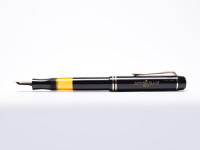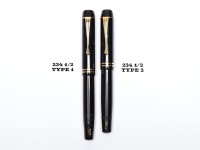Details
MONTBLANC 234 1/2 - Series One
Manufacturer/Model: Montblanc/Germany/"234 1/2" Inscription on the turning knob cap
Year of production: 1936-1939
Filling system: Three stage Telescopic Piston (Two new rubber O-rings installed to replace the original wooden cork and create perfect seal and smooth operation)
Nib: 14K 585 Gold; EF Extra Fine Size - Super Flexible writes to 3B - triple broad
Material: High Shine Black Celluloid, Amber yellow color ink window; Gold Filled Trimmings. Telescopic piston made out of brass. Ivory color cap Montblanc Mountain Top Snow Star
Dimensions: 130mm; Posted at 149; 13.5mm Cap Diameter; 12mm Body Diameter; Overall cap length with clip and crown 62mm; Overall body length without nib with turning knob cap: 97.5mm; Nib/Feed size No.5 (5mm diameter)
Condition and information:
We are very proud to finally offer this truly remarkable Montblanc pen from the amazing Attic Find from several months ago (you can read more about this rare find in our Blog post). This is the first Montblanc fountain pen to be listed from this Find, which included over 300 pens and from those, more than a dozen were Montblanc pens and pencils from mid 1930s to early 1940s when the Shop closed and these pens were hidden only to be found many decades later. The first Montblanc item we have listed from this find was the remarkable Montblanc 72 PL Pix Tiger Eye Pencil. This find was also covered in an article by The Pelikan's Perch, with more emphasis placed on the Pelikan pens in the find, but it gives a good context to the Find in general. You can read the article here: "Treasures In The Attic: A Time Capsule Rediscovered"
The pen offered here is the Type 1 Montblanc 234 1/2. There are several variations on the 234 1/2 but they can be generally divided in two types, Type 1 such as this pen is the variant which is longer, both in body and in cap length, and has the telescopic piston mechanism which is screwed/mounted from the back end of the barrel. The Type one was produced from approximately 1936 to 1939 in this variant, which places this pen exactly in the time period we assume the shop was closed. There is also a Type 1 variant without cap rings which was made during the war years due to restrictions on metals and precious metals for non-essential war efforts. That variant was produced between 1940 to 1942. The Type 2 234 1/2 is a slightly shorter pen, both in barrel and in cap lengths, but features the same feed and nib size. Most notably however, the Type 2 234 1/2 has a standard non-telescopic piston mechanism which is mounted from the front end of the barrel by removing the section. The best way to discern which type a particular 234 1/2 is, is simply by the barrel section right under the turning knob cap; the Type 1 has it as this section is where the piston is screwed in and D.R.P. 652405 patent number engraved, while the Type 2 does not have this section under the turning knob and no patent number engraving. The "D.R.P. 652405" is the actual patent file number for the Montblanc piston filling patent, patented in 1933/34, and this number can be found engraved on many Montblanc telescopic piston fountain pens from mid 1930s to late 1940s. You can see a photo of these two pens right next to each-other on the last photos. Interestingly though, both these types had been produced sometimes in parallel, so it's not as one variant was discontinued and the other introduced, they both appear in some later post 1939 years up until 1942 and the Type 2 variant also up until 1954 with its G subvariant meaning Luxury variant and also in different colors than black. In the coming days we will also list the Type 2 variant on our website. In addition to these there are several other variations to the 234 1/2 model, starting from caps with two bands, one band, no bands at all, red, green or amber ink windows, variations on the clip design and even different material nibs, from gold to palladium and even steel nibs in the war time productions. All in all there are about half a dozen or so variations on the 234 1/2 model.
This pen was manufactured somewhere between 1936 and 1940, and being the one of the first Montblanc piston filling pens which launched in 1934, it features the amazing telescopic piston system. No matter how many of these we have handled, restored or just fine tuned in our shop, we are always amazed by the ingenuity of the telescopic piston filling system. Even though Pelikan beat them to the market in 1929 with the original piston filling mechanism patented by Mr. Kovacs, Montblanc had to find another solution around the differential piston system in order not to get sued by Pelikan. After several years in research they came up with the telescopic differential piston system and launched it in 1934. This telescopic piston system compared to the standard piston system is like comparing a race car to a normal road car. The piston is engineering perfection, streamed and stripped down to almost watchmaking precision and manufacturing techniques. Its extended position is over triple in its retracted length. It's simply hard to believe how long it can extend and how compact it gets when retracted, the rotation on the turning knob seems endless. This had several benefits; besides the most obvious one that it had enormous range of movement, this provided for a extremely large ink reservoir, as where other piston fillers just stops halfway through the barrel length, this one retracts far back inside the turning knob and utilizes more than 3/4 of the barrel length as a useful ink reservoir, and in some respects becomes almost as compact as on other piston fillers turning knobs. Another benefit is as when it is fully retracted, all of the weight is on the back end of the pen. This weight distribution moves the center of gravity far on the back on the palm where the pen rests while writing and makes the pen feel more balanced and the nib lighter when writing, while still weighing considerably more than other pens, simply perfect feel and handling. Unfortunately, this system was so difficult to precision make to be fully reliable, that eventually in the late 1950s Montblanc decided to ditch it and switched to the standard piston filling mechanism we all know today. Ironically though, even when they came up with it in 1934, they didn't dodge the some lawsuits that followed shortly after and still had to defend. Apparently the lawsuits were settled outside court by both companies agreeing to share some of their patents and technology, which included the rights of the standard piston filling mechanism.
The pen is in absolute mint condition, with no signs of deformations or shrinkage, dents, dings, scratches or cracks. As we mentioned in the Pix 72 PL pencil listing, unlike some other pens in this find, the Montblanc pens showed some signs of use, like ink residue or similar hints, either that being from a lightly used pen to testing or pens brought back for repair, we cannot say for sure, but almost all of them had some ink residue inside them, which would suggest at some point they were filled with ink. We could also see some traces of ink on the original wood corks, which is the best indicator if a pen had been used, as no matter how good the pen is cleaned the wood cork will instantly absorb some ink if it comes in contact with. Regardless, all of the pens including this one were in pristine condition, seemed barely used, and that is still evident today. The pen has all of its original gold filling paint in its engravings both on the cap "Montblanc" mountain range logo and the turning knob model engraving. Caps rings are in perfect condition, the clip too with no brassing or gold wear off. The only part we have replaced on the pen was its original wood cork, and replaced it with a perfect size-to-barrel match two rubber O-rings which make the pen fill and operate even better. The O-rings create a perfect seal with the inner barrel, providing for a smoother and safer piston movement, and do not require the occasional filling and maintenance wood corks do, besides that the rubber O-rings do not make squeaking noises as some dried wood corks can.
The pen is a master writer with a very nice and precise EF extra fine nib. As most of the nibs from this era were super flexible, this one is no exception, it melts on the paper as soon as it touches it, and with a slight pressure it will produce anything up to 3B or tipple broad as the feed features a nice wide ink canal.
And this is the part where to our amazement we have discovered an Easter egg inside this pen, a thing we have only heard of but never seen in person. Upon removing the nib and feed, besides the traces of ink inside the pen, on the first glance it seemed as if there was some dried ink in the ink canal. When removing this "dried ink" from the feed ink canal, to our amazement, we discovered that this actually is not dried ink, it is rather a needle placed inside the ink canal. The needle goes from the pre-feed reservoir (the circular cutout on the back of the feed), all the way to the front end of the feed where the canal tapers towards the face of the feed to come in contact with the back side of the nib and feed it the ink. The needle is pointed only on the side facing the nib tip and it is simply freely/loosely placed inside the ink canal and not forced inside. This was a technique done by the old pen meisters in order to restrict or rather reduce the ink flow through the feed. The ink still has plenty of space to pass/flow around the needle, but the flow is restricted by the volume of space the needle takes. If one were to remove the needle the pen will write much more wetly, let's say for sizes M, B, BB, etc. By placing the needle back into the canal, the ink flow will be reduced suitable for nibs with EEF, EF, F ext. This will also explain why the nib size marking on the turning knob is "M" while the size of the actual nib on the pen is EF size. We can say with confidence that neither we nor the previous owners had replaced the nib or the turning knob cap on this pen, so it is definitely as it was somewhere in the early 1940s or maybe even late 1930s. What we presume happened is that the pen was originally sold with an M size nib, and at some point later it was brought back to the shop for a nib swap with a EF size nib. Since now the original feed's ink canal was too wide for an EF nib, the shopkeeper placed a needle inside the feed to restrict the flow accordingly to suit a EF size nib. We cannot see any traces of nib grinding done to the nib, i.e. reducing its size from M to EF, rather we can confidently state and see that this is an original EF size nib from the factory. The pen writes beautifully with and without the needle inside the ink canal, and with an obvious difference with or without it. Without it the pen is extremely wet writer and can support the flex nib needs, and when placed it is very confined on ink flow and will produce only EF and F lines regardless of how much is pressed while writing (writing samples photos coming soon). We will ship the pen with or without the needle installed in the feed, per your choice. Even if you choose not to have the needle installed in the feed, we will ship it to you with the pen as an accessory you can opt to place inside the feed at any time in the future.
The nib is a masterpiece of its own. A size 5 nib with full flexibility as they used to make them. It is EF fine size and it is a fully flexible nib that simply immerses itself on the paper. The pen will write lines more than 2mm wide on the down strokes. Depending on the way it's held, fast side strokes can be thin, and using the flex can add to the variation. Basically there is no line this pen cannot produce; some of the best writing one could hope to achieve with a fountain pen. Since the ebonite feed is large and with a wide ink canal, it will feed this hungry nib without interruption, providing steady ink flow.
This one of those pens with a perfect balance, perfect form factor, perfect feel and writing experience, perfect appeal and quality. There is nothing like these old celluloid Montblanc pens. The build quality is amazing with stunning depth of amber an black color celluloid colors, immense attention to detail but also a "form follows function" design embodied by the Bauhaus movement. This pen is also often referred to as "The Officer's Pen" as presumably many of the German officers had this model pen on them. It's hard to believe that such pens were made nearly 90 years ago.
The trimmings and the clip unlike the newer models are thick gold filled, so no gold wear off will occur. 2 gold bands on the cap help prevent cracks. Yellowish ivory like star on the crown with a distinct vintage appeal to it. Perfectly preserved original Montblanc pen, ready to be used and enjoyed daily. The pen is not restored, no repairs had been performed or any parts replaced, the pen is only painstakingly disassembled, cleaned and polished. Only the original wood cork is replaced to improve the performance and safety of the pen. Even though a complex piston pen, the pen is super easy to clean and maintain. The user can simply unscrew the piston from the barrel (it is a normal thread) and expose the entire piston mechanism and barrel. The mechanism and threads are only slightly silicone greased making them easy to unscrew and screw back in at any time. Since the cork is replaced with rubber O-rings, there is no danger of the cork being damaged and falling apart during disassembly, as the O-rings will always go easily inside the barrel and make a good contact and seal inside the barrel. The nib and feed are friction mounted within the section and can be easily removed simply by pulling them out.
In the following weeks we will continue to list more Montblanc pens from this find, so make sure to visit our website occasionally and check them out.
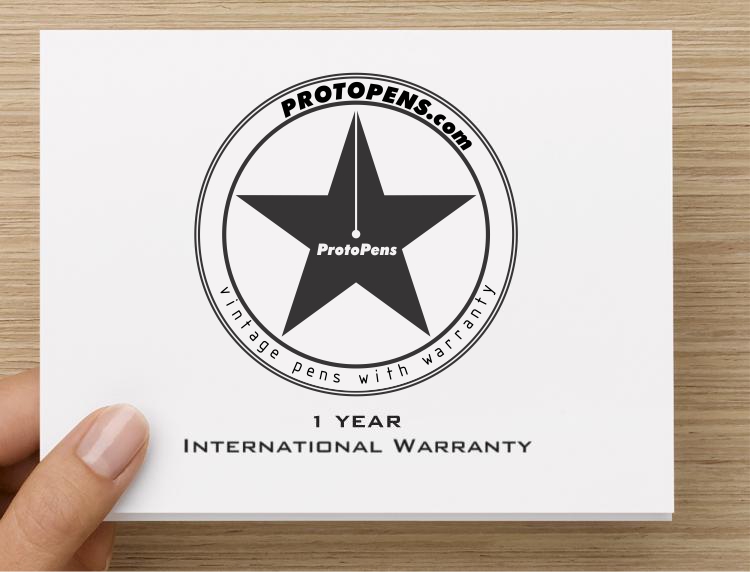
This item is covered by our 1 Year Full International Warranty at no additional cost. The terms of our Warranty are very simple, meant to give you a secure and trouble-free buying experience.
-
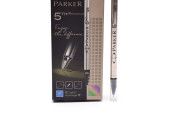
New Genuine Large PARKER Ingenuity Blue 5th Mode Technology Gen Generation 202 F Fine Fineliner Refill Made in Germany
$8.99 -
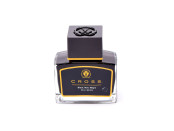
NOS Special CROSS Black Noir Negro Archival ISO Standard Bottled 2 fl. oz. | 62.5ml Fountain / Dip Pen Ink in Glass Bottle
$16.99 -
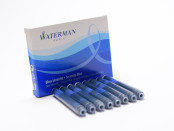
New WATERMAN Paris Standard International Format Made in France Serenity Florida Blue Large Size Fountain Pen Ink Cartridges Refills - Pack of 8
$6.95 -
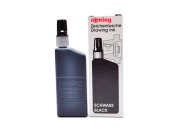
23ml Rotring Rapidograph Isograph Technical Drawing Waterproof Ink in Tube Schwarz Noir Black - Made in Germany
$9.95 - More Ink & Refills ...
-
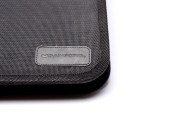
Rare Sanford 36 Slots High Quality Black Hardcover Zipper Pouch Case Holder/Folder Made in U.S.A by COLOMBIA TWO INC Portland Oregon
Regular Price: $199.99
Special Price $58.99
-
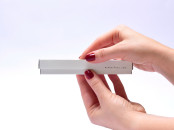
Pack of 5 ProtoPens Vintage Style Safe Keeping Storage Shipping and Organizing Fountain Ballpoint Pencil Pen Case Box
$8.99 - More Cases ...
This item is located in Europe and ships Worldwide.
At checkout you can choose between two shipping options:
$12.95 Regular Postal Service, Priority & Registered Airmail - Limited Tracking 1-4 WEEKS Delivery
$48.95 DHL Express International - Accurate Tracking 1-4 DAYS Delivery Worldwide
Learn more about these shipping options.
Prior shipping our items have to pass our highest quality control inspection, are perfectly cleaned and tested by ProtoPens pen staff after which are carefully packed. If the pen does not come in its original manufacturers box, it is packed in a special ProtoPens case.
RETURS: Returns are accepted. You are welcome to ship the item back to us within 7 days after receiving it in the same condition it was delivered to you and we will issue you a full refund! Learn more...
(NOTE: If you don’t receive an email from us soon, please check your email spam folder)







